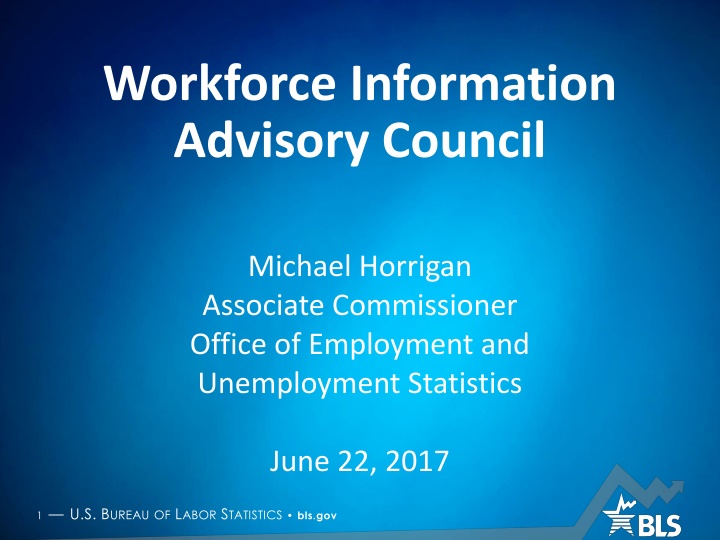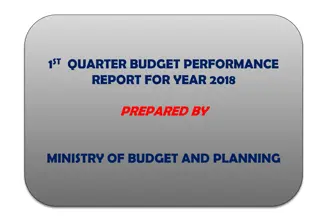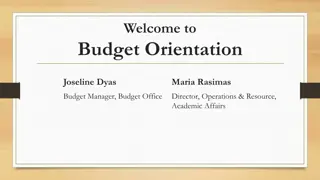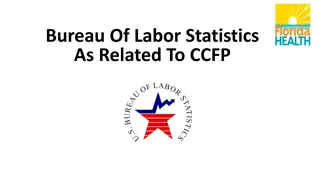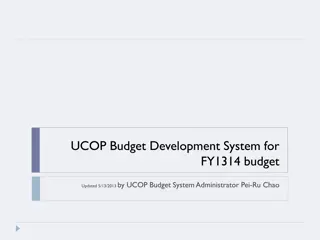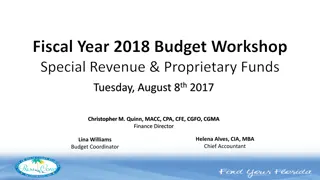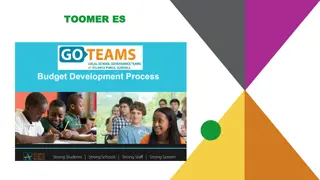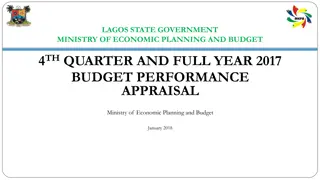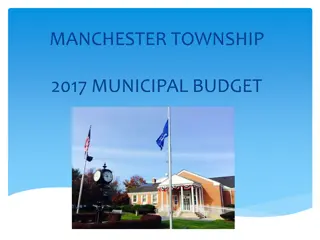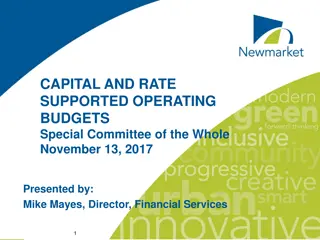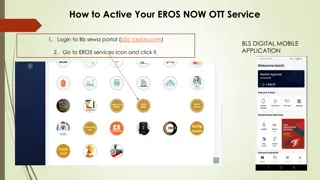BLS Budget Overview FY 2017-2018
The Bureau of Labor Statistics (BLS) budget overview for FY 2017-2018 discusses funding levels, new initiatives, program reductions, and future plans. Despite proposed changes, the BLS aims to maintain core data series production and enhance user services.
Download Presentation

Please find below an Image/Link to download the presentation.
The content on the website is provided AS IS for your information and personal use only. It may not be sold, licensed, or shared on other websites without obtaining consent from the author.If you encounter any issues during the download, it is possible that the publisher has removed the file from their server.
You are allowed to download the files provided on this website for personal or commercial use, subject to the condition that they are used lawfully. All files are the property of their respective owners.
The content on the website is provided AS IS for your information and personal use only. It may not be sold, licensed, or shared on other websites without obtaining consent from the author.
E N D
Presentation Transcript
Workforce Information Advisory Council Michael Horrigan Associate Commissioner Office of Employment and Unemployment Statistics June 22, 2017 1 U.S. BUREAU OF LABOR STATISTICS bls.gov
Outline BLS Budget BLOC Vision Joint BLOC-PC meeting BLOC projects Communications 2 U.S. BUREAUOF LABOR STATISTICS bls.gov 2 U.S. BUREAUOF LABOR STATISTICS bls.gov
BLS Budget 3 U.S. BUREAUOF LABOR STATISTICS bls.gov
BLS Budget FY 2017 The FY 2017 President s budget proposed $641 million in funding for BLS, an increase of $33.2 million over the FY 2016 final enacted level A large share of this request was to cover higher costs due to inflation, including $13 million not provided in the FY 2016 enacted level It also included 3 new initiatives: Employer Training Survey ($3 million) CPS supplement ($1.6 million) Supplemental Poverty ($2.5 million) 4 U.S. BUREAUOF LABOR STATISTICS bls.gov 4 U.S. BUREAUOF LABOR STATISTICS bls.gov
BLS Budget FY 2017 On May 5 the President signed the Consolidated Appropriations Act. This keeps the BLS funding level for this year at the FY 2016 appropriated level of $609 million In order to maintain current production and core programs, at this funding level, the BLS has been curtailing spending on data improvements, and development and research projects. In addition, the BLS has cancelled particular trainings, including program-wide training of staff and state partners This included the cancellation of the BLS-LMI Conference, fed/state cooperative program national conferences and Policy council meetings 5 U.S. BUREAUOF LABOR STATISTICS bls.gov 5 U.S. BUREAUOF LABOR STATISTICS bls.gov
BLS Budget FY 2018 On May 23, the President submitted to Congress his 2018 Budget The 2018 President s Budget proposes $607.8 million in funding for the BLS. This request is a decrease of $1.2 million from the FY 2016 final enacted level Within this level, the BLS will continue the production of core data series, as well as, take on select projects that will improve the products provided to our data users 6 U.S. BUREAUOF LABOR STATISTICS bls.gov 6 U.S. BUREAUOF LABOR STATISTICS bls.gov
BLS Budget FY 2018 The BLS will consider efficiencies and changes in our operations, including changes to some programs that may be necessary in order to reallocate funding to the production of core data series The plan for FY 2018 also includes reversible non- permanent programmatic reductions that may temporarily affect the quality and quantity of select BLS products 7 U.S. BUREAUOF LABOR STATISTICS bls.gov 7 U.S. BUREAUOF LABOR STATISTICS bls.gov
BLS Budget FY 2018 OEUS planned reversible cuts QCEW $2.4 million Eliminate state contribution of $1 million to QUEST Coding requirement changes $1.4 million OES $1.2 million Reduce sample by 6.5% (26,000) Most metropolitan divisions would not be published and some small balance of state areas will be combined with other areas 8 U.S. BUREAUOF LABOR STATISTICS bls.gov 8 U.S. BUREAUOF LABOR STATISTICS bls.gov
BLS Budget FY 2018 OEUS reversible cuts LAUS reduction $500,000 Eliminate 441 New England Minor Civil Divisions with populations less than 1,000 CES reduction $400,000 Eliminate two specific deliverables: annual summary of state contributions to the benchmark, and delivery of information to BLS on local events in the analysis of estimates OEUS total planned reversible cuts affect all of OEUS programs, not just fed/state 9 U.S. BUREAUOF LABOR STATISTICS bls.gov 9 U.S. BUREAUOF LABOR STATISTICS bls.gov
Vision 10 U.S. BUREAUOF LABOR STATISTICS bls.gov
Vision Prioritizing closing major data gaps Measuring jobs in demand Expanding local detail Increased use of modelling Increased use of visualization The future of data collection Creation of new products 11 U.S. BUREAUOF LABOR STATISTICS bls.gov 11 U.S. BUREAUOF LABOR STATISTICS bls.gov
Vision prioritizing closing data gaps What industries are temporary help workers being placed in? How firms produce their products or provide their services Types of labor W&S, temporary help, contract, self-employed, among others Purchased inputs Offshoring Employer provided training 12 U.S. BUREAUOF LABOR STATISTICS bls.gov 12 U.S. BUREAUOF LABOR STATISTICS bls.gov
Vision prioritizing closing data gaps Globalization and enterprise based data collection Factoryless goods production Global supply chains Value added trade Occupational, industry and product classification systems 13 U.S. BUREAUOF LABOR STATISTICS bls.gov 13 U.S. BUREAUOF LABOR STATISTICS bls.gov
Vision measuring jobs in demand New way to measure jobs in demand Develop time series of occupational employment changes Develop thresholds for employment change over time Identify high-wage occupation thresholds Sort by educational attainment generally required for entry into the occupation Set other thresholds such as size of occupation, number of new jobs created, etc 14 U.S. BUREAUOF LABOR STATISTICS bls.gov 14 U.S. BUREAUOF LABOR STATISTICS bls.gov
Vision measuring jobs in demand OES time series New way to measure jobs in demand Short-term complement to using long-term projections Impute OES back to the QCEW to provide local detail and better estimates 15 U.S. BUREAUOF LABOR STATISTICS bls.gov 15 U.S. BUREAUOF LABOR STATISTICS bls.gov
Vision Expanding local detail Increased use of modelling Modelling JOLTS to the state level Develop OES time series estimates down to lower levels of geography Blending data through ratio allocation and modelling to create more local detail Use of Mean Squared Error reduction as a measurement objective 16 U.S. BUREAUOF LABOR STATISTICS bls.gov 16 U.S. BUREAUOF LABOR STATISTICS bls.gov
Vision Expanding local detail Increased use of visualization Creating local profiles by combining data across BLS and other data sets Mapping technology 17 U.S. BUREAUOF LABOR STATISTICS bls.gov 17 U.S. BUREAUOF LABOR STATISTICS bls.gov
Vision - Modernization of data collection and lowering response burden Elimination of long forms in OES and autocoding ARS to email and to QBS Expansion of EDI Payroll providers Wage records and OES 18 U.S. BUREAUOF LABOR STATISTICS bls.gov
Vision - Leveraging corporate data A large share of collected information in our establishment surveys comes from a small share of total establishments owing to the size concentration of economic activity The Current Employment Statistics Survey (CES) collects data from 88 corporations at the Electronic Data Interchange Center in Chicago, IL Accounts for nearly 10% of total weighted employment Respondents submit electronic files in BLS formats 19 U.S. BUREAUOF LABOR STATISTICS bls.gov 19 U.S. BUREAUOF LABOR STATISTICS bls.gov
Vision - Leveraging corporate data In 2012, of the known value of U.S. exports that could be matched to specific companies: the top 50 companies contributed nearly 31% of known value the top 100 nearly 40% the top 250 just over half and the top 2000 nearly 78% 20 U.S. BUREAUOF LABOR STATISTICS bls.gov 20 U.S. BUREAUOF LABOR STATISTICS bls.gov
Vision - Development of new and innovative products: New potential surveys Survey of Employer Provided Training Quick response surveys of establishments 21 U.S. BUREAUOF LABOR STATISTICS bls.gov
Vision: Development of new and innovative products: Matching QCEW-Nonprofit QCEW-FDI QCEW-OES QCEW-SOII-OES QCEW-Customs Exports-OES 22 U.S. BUREAUOF LABOR STATISTICS bls.gov
Vision: Development of new and innovative big data products: Wage records Wage record pilot Resurrect the Mass Layoff Survey Model JOLTS to the state level UI non-filers study OES 23 U.S. BUREAUOF LABOR STATISTICS bls.gov
Vision - Development of new and innovative products Cross-program products Local profiles Videos Infographics Training and software 24 U.S. BUREAUOF LABOR STATISTICS bls.gov 24 U.S. BUREAUOF LABOR STATISTICS bls.gov
Joint BLOC Policy Council Meeting 25 U.S. BUREAUOF LABOR STATISTICS bls.gov
Joint BLOC PC meetings: Cross-program topics Managing state level staffing Best practices - hiring, training, management challenges, innovative practices Declining trends in response rates Response rate improvement projects, federal, and state perspectives Annual Refiling Survey Review current test of moving the quarterly state deliverable up by one week, impact on programs, and review of state concerns 26 U.S. BUREAUOF LABOR STATISTICS bls.gov 26 U.S. BUREAUOF LABOR STATISTICS bls.gov
Cross-program topics Cross-program product development Sharing examples of approaches to creating new innovative products combining data from multiple sources, infographics, matching administrative and survey data, among others Wage records State experiences with sharing and enhancing wage records, best practices, lessons learned, future opportunities 27 U.S. BUREAUOF LABOR STATISTICS bls.gov 27 U.S. BUREAUOF LABOR STATISTICS bls.gov
BLOC projects 28 U.S. BUREAUOF LABOR STATISTICS bls.gov
BLOC projects Wage records Examination of the adequacy of budget resources for fed/state programs Strategic planning Jobs in demand 29 U.S. BUREAUOF LABOR STATISTICS bls.gov 29 U.S. BUREAUOF LABOR STATISTICS bls.gov
Wage records BLS Pilot Texas, Louisiana, Utah, Washington, Oregon, and Idaho Testing sharing protocols and IT requirements using fake data Creating sharing agreements WRAWG OMB, Census, DOL, BLS, and Ed joint effort 30 U.S. BUREAUOF LABOR STATISTICS bls.gov 30 U.S. BUREAUOF LABOR STATISTICS bls.gov
BLOC budget subgroup Evelina Loescher, Carrie Mayne, Mark Watson, Mike Horrigan, Tom Shaffer, Charlene Peiffer, Brent Hill Develop an analytical approach to determining if the BLS fed/state programs are adequately funded Meets every two weeks Development of an analytical approach that we will discuss with the BLOC 31 U.S. BUREAUOF LABOR STATISTICS bls.gov 31 U.S. BUREAUOF LABOR STATISTICS bls.gov
Strategic Planning: Vision buckets Ken Robertson, Julie Hatch, Evelina Loescher, Carrie Mayne Achieve and maintain high data quality Provide excellent customer service Close high priority data gaps Leverage opportunities for new products Improve fed/state coordination Conduct high quality research Provide high quality data driven resource management Provide high quality program oversight 32 U.S. BUREAUOF LABOR STATISTICS bls.gov 32 U.S. BUREAUOF LABOR STATISTICS bls.gov
Jobs in demand Rebecca Rust Pathways project Too much heterogeneity Focus on skills Survey of LMI Directors on how states measure jobs in demand 33 U.S. BUREAUOF LABOR STATISTICS bls.gov 33 U.S. BUREAUOF LABOR STATISTICS bls.gov
Communication 34 U.S. BUREAUOF LABOR STATISTICS bls.gov
Challenge to the BLOC and PCs Budget shortfalls are necessitating the cancellation of the BLS LMI conference and various BLOC, Policy Council, and program national conferences for the remainder of the year We hope to resume the normal practice of holding these meetings in FY 18 3 BLOC and 3 Policy Council meetings BLS National LMI conference and fed/state program national conferences 35 U.S. BUREAUOF LABOR STATISTICS bls.gov 35 U.S. BUREAUOF LABOR STATISTICS bls.gov
New communication channels Create a new WebEx series for meetings on broad topics of interest for all LMI directors Budget updates Major BLOC projects OEUS annual planning memo Major Policy Council projects fed/state research studies More frequent virtual meetings in-between in-person 36 U.S. BUREAUOF LABOR STATISTICS bls.gov 36 U.S. BUREAUOF LABOR STATISTICS bls.gov
Contact Information Michael W. Horrigan Associate Commissioner Office of Employment and Unemployment Statistics 202-691-5735 horrigan.michael@bls.gov 37 U.S. BUREAUOF LABOR STATISTICS bls.gov
